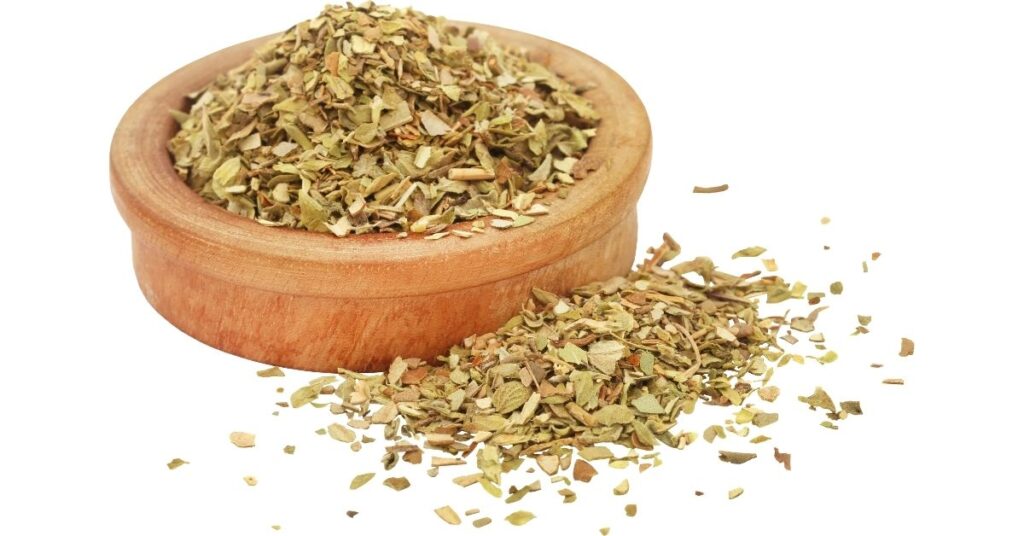No, Dried oregano doesn’t expire but loses flavor over time, remaining safe to use indefinitely.
Does Oregano Expire?
Yes, oregano does expire – but maybe not in the way you think. It won’t go bad or make you sick. Oregano, like other dried spices, simply loses its flavor and potency over time. So, while it’s technically safe to use past its prime, it won’t pack the same flavorful punch.
Understanding Oregano Shelf Life
Dried oregano can last anywhere from 1-3 years if stored properly. That’s significantly longer than fresh herbs! Here’s a quick breakdown of how different forms of oregano impact their lifespan:
| Type of Oregano | Typical Shelf Life |
| Dried Oregano | 1-3 years |
| Fresh Oregano | 1-2 weeks |
| Ground Oregano | 6 months – 2 years |
How to Tell If Your Oregano Has Lost Its Potency
You don’t need a lab test to figure out if your oregano is past its prime. Here’s a super simple freshness test:
- Rub it: Grab a pinch of oregano and rub it between your fingers.
- Smell it: Does it still have a strong, aromatic scent?
- Taste it: If the flavor is weak or almost non-existent, it’s time for a new batch!
If your oregano fails this test, don’t worry about tossing it immediately. Oregano that has lost its flavor might still be fine to use in some dishes where other strong flavors are present.
How to Store Oregano for Maximum Freshness
The key to keeping oregano flavorful is all about proper storage. Here’s what you need to do:
- Choose the right container: Store your dried oregano in an airtight container. Glass jars with tight-fitting lids are perfect.
- Find a cool, dark place: Heat and light are enemies of dried herbs! Store your oregano in a cupboard or pantry away from direct sunlight and heat sources like the stovetop.
- Avoid moisture: Humidity is another culprit that can cause herbs to lose their flavor faster. Don’t store oregano above the stove where it might be exposed to steam.
Tips for Using Oregano
Now that you’re an expert on storing oregano, how do you actually use it to get the best flavor? Here are a few quick tips:
- Add it toward the end of cooking: Heat can diminish oregano’s flavor, so try adding it near the end of cooking for maximum impact.
- Bloom it in oil: Briefly heat dried oregano in a bit of olive oil before adding it to a dish. This helps release its flavorful oils.
- Pair it with complementary flavors: Oregano is a classic Italian herb, so it works beautifully with tomato sauce, garlic, basil, and other Mediterranean flavors.
Table 1: Oregano Flavor Pairings
| Flavor | Notes | Example Dishes |
| Tomato | Sweet and acidic | Pizza, pasta sauces, tomato soup |
| Garlic | Earthy and pungent | Marinades, roasted vegetables, chicken dishes |
| Basil | Sweet and slightly peppery | Caprese salad, pesto, pasta |
| Olive Oil | Rich and fruity | Salad dressings, dips, grilled vegetables |
Can You Freeze Oregano?
Absolutely! Freezing extends the life of both fresh and dried oregano. Here’s how to do it:
Freezing Fresh Oregano
- Wash and dry: Give your fresh oregano a quick rinse and pat it dry with a paper towel.
- Flash freeze: Spread the leaves on a baking sheet and pop them in the freezer for about an hour.
- Transfer to a container: Once frozen, move the oregano leaves into a freezer-safe bag or airtight container.
Freezing Dried Oregano
- You can freeze dried oregano as well! Since it’s already dry, there’s no need to flash freeze. Simply store it in a freezer-safe bag or container.
Frozen oregano can last up to a year. When you’re ready to use it, there’s no need to thaw – you can toss it directly into your dishes!
Substitutes for Oregano
If you’ve run out of oregano or your supply is no longer at its best, don’t panic! Here are a few substitutes that can work in a pinch:
- Marjoram: Marjoram is a close relative of oregano, with a slightly sweeter and more delicate flavor. Use a 1:1 ratio when substituting.
- Thyme: Thyme has a woodsy, earthy flavor that complements many of the same dishes as oregano. Start with a smaller amount, about half as much as you would oregano, and adjust to taste.
- Italian Seasoning: Italian seasoning usually contains oregano, along with other herbs like basil, rosemary, and marjoram. It can be a good substitute, though the flavor profile will be slightly different.
Beyond Cooking: Other Uses for Oregano
Oregano isn’t just for the kitchen! Here are a few interesting ways it has been used throughout history:
- Natural Remedy: Oregano has been used in traditional medicine for digestive issues, respiratory problems, and skin conditions. While more research is needed, its potential benefits are intriguing.
- Insect Repellent: The strong aroma of oregano can help deter some insects. You can try sprinkling dried oregano around your home or growing fresh oregano in your garden.
- Fragrance: Oregano’s essential oil has a warm, herbaceous scent and is sometimes used in aromatherapy and natural perfumes.
Table 2: Oregano Nutritional Facts
Serving size: 1 teaspoon (1.4 grams)
| Nutrient | Amount | % Daily Value |
| Calories | 5 | – |
| Total Fat | 0g | 0% |
| Carbohydrates | 1g | 0% |
| Fiber | 1g | 4% |
| Vitamin K | 8 micrograms | 10% |
| Calcium | 21 milligrams | 2% |
| Iron | 1.2 milligrams | 7% |
Conclusion- Does Oregano Expire?
Does oregano expire? Technically, no. But it does gradually lose its flavor and aroma over time. By storing your oregano properly and checking it for freshness before use, you can ensure you’re always getting the most vibrant flavor from this versatile herb.
